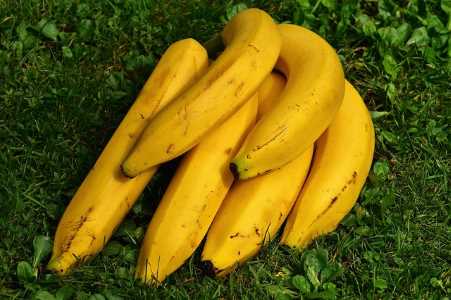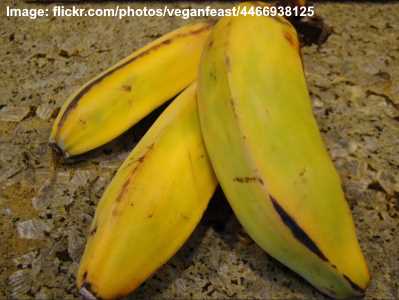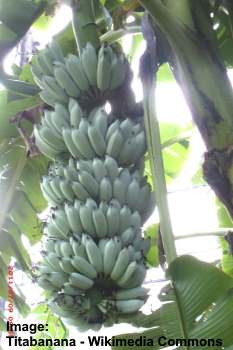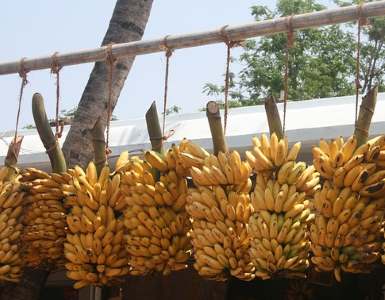Types of Bananas: Delicious and Nutritious Banana Varieties From Around the World (Including Pictures)
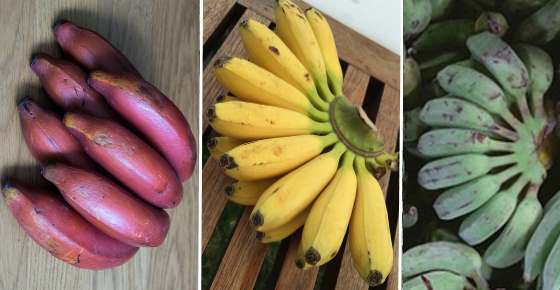
Bananas are a type of edible fruit that grow in many tropical countries. The common banana is a long-curved fruit with yellow-colored peel and starchy soft flesh. There are around 1,000 varieties of bananas in different sizes, shapes, and even colors. For example, there are small red bananas, long plump green bananas, purple bananas, and chubby baby bananas that are only 3” (7.5 cm) long.
All varieties of bananas belong to the Musa genus in the Musaceae family. Botanically speaking, bananas are a type of berry fruit and they grow in more than 150 countries. It is thought that bananas originated in West Africa, and in the native African language the fruit was called locally as banaana.
Banana trees are usually grown for their healthy fruit, but bananas and the banana plant have many more uses. For example, fiber from banana trees can be used to make clothing, and banana leaves are commonly used for wrapping food.
In this article, you will learn about many different species of banana, such as Cavendish, apple banana, baby banana, red banana and plantain. You will find out that bananas are not just long yellow-skinned fruits, but can be red, blue, purple, green, and black types of fruit.
At the end of the article, you will also find out why eating bananas is so good for you.
Common Types of Bananas (With Pictures and Names)
Let’s look at some types of common bananas that you can readily buy in the store. We will also look at some less well-known varieties of bananas that you might only find in health or specialty stores.
Cavendish Bananas
Cavendish banana is the most familiar subgroup that belongs to Musa acuminata species which is native to Southeast Asia. These are the most common banana variety on sale in most stores. According to some estimates, Cavendish bananas account for nearly half of all bananas grown and exported around the world.
There are a number of banana cultivars in the sub-group of Cavendish bananas. Like most bananas, Cavendish bananas are green when they are immature. As they ripen, they turn a bright yellow color, and black/brown spots may appear on the skin. Cavendish bananas are usually sold while they are still slightly green and they will ripen in a few days.
Some popular Cavendish banana cultivars include ‘Dwarf Cavendish,’ ‘Giant Cavendish,’ and ‘Williams.’ Another classification of banana is the ‘Grande Naine’ which is also called the Chiquita banana.
One of the reasons why Cavendish bananas are so popular is because they are a sweet variety of fruit. In fact, they are also classified as a dessert banana. Their ripe soft flesh is delicious eaten raw. Even when Cavendish bananas turn brown, their sweetness intensifies and you can add them to smoothies or use them to make banana bread.
Gros Michel (Big Mike) Bananas
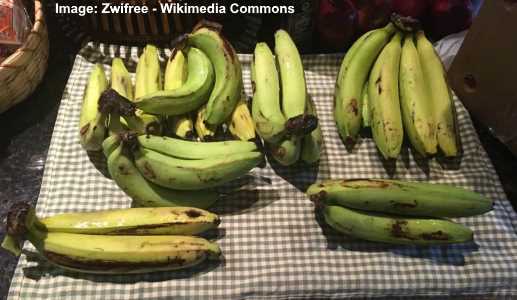
Gros Michel bananas used to be the most popular type of banana before the Cavendish bananas took their place and are one of the biggest types of bananas
Before Cavendish bananas became so popular, the Gros Michel cultivar was the most popular type of banana. One of the biggest types of bananas, the large size of the banana and its thick peel means that it is an excellent export banana.
These large long bananas are no longer widely available in Western countries as they used to be. Disease wiped out most of the crop in the 1950s and since then Cavendish bananas have become the most popular banana in the world. However, Gros Michel cultivars are still a popular banana in Asia, with Thailand and Malaysia producing the most crop.
For many people, ‘Big Mike’ bananas are tastier than Cavendish bananas. Gros Micel cultivars have a rich creamy texture and a more robust and sweeter taste.
Burro Bananas
Burro bananas are a variety of small yellow banana that are somewhat shorter and chunkier than Cavendish bananas.
These small bananas only grow to about 6” (15 cm) in length. They have a square shape and stumpy appearance. The dark green flesh gradually turns deep yellow as the banana ripens. Before they are fully ripe, Burro bananas have a tangy taste and a firm texture. As they ripen, their flesh becomes much sweeter and has a dense texture.
You can eat Burro bananas raw and they are also good for cooking due to their firm texture.
Manzano Bananas (Apple Bananas)

Manzano banana is a type of short banana cultivar that is also known as apple banana or Latundan banana
Another type of small banana is the Manzano banana cultivar (also called Apple banana) . This may not be the smallest banana variety, but it has a short length and chubby look to it. In fact, these “mini” bananas only grow to about 4” (10 cm) in length.
Manzano bananas are classed as a hybrid cultivar and are a cross between Musa acuminata and Musa balbisiana. They are also called Latundan bananas, Silk Bananas, or Apple Bananas. Compared to Cavendish bananas, Manzano fruits have a firmer texture.
As with most banana types, Manzano bananas start off green and then gradually become yellow as they ripen. To enjoy this bananas variety at its sweetest, wait until the thick skin has almost turned black. The soft flesh will be extremely sweet and much sweeter compared to Cavendish bananas.
Their sweetness when fully ripe can resemble tropical tastes of pineapple and apples. This is one of the reasons why Manzano bananas are also called the ‘apple banana.’
Just like most bananas, Manzano (apple) bananas are a rich source of potassium and other minerals.
Lady Finger Bananas
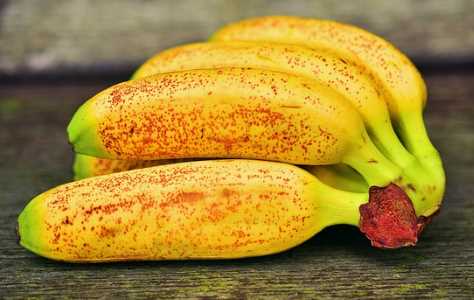
Lady Finger Bananas (sugar bananas) are the most popular type of banana in Southeast Asia and is one of the smallest varieties of banana
Lady Finger bananas (a cultivar of Musa acuminata) are a small banana variety that taste extremely sweet and have a soft, creamy texture.
Due to their intense sweetness, ‘Lady Fingers’ are also called the ‘Sugar banana,’ ‘Fig banana,’ or ‘Date banana.’ Lady finger bananas are the most popular type of banana in Southeast Asia. They are often deep-fried in batter to create banana fritters.
Sometimes Lady Finger bananas are referred to as baby (Nino) bananas as they are one of the smallest varieties of banana. These miniature bananas may only measure 3 inches (7.5cm) in length. In fact, the tiny bananas are small enough to fit in the palm of your hand.
When Lady Finger bananas become fully ripe, they have yellow skin with some brown spots. Peeling away the thin banana peel reveals rich banana flesh with a honey-like taste.
In some countries, the name ‘Lady Finger bananas’ can refer to other types of banana cultivars. For example, in Australia ‘Lady Fingers’ are the Pome banana (Musa acuminata and balbisiana) or in Hawaii, they are the Ney Poovan banana.
Compared to Burro bananas or Manzano bananas, they are not as squat or chunky in shape.
Red Bananas
Red bananas (Red Dacca) refer to a classification of banana cultivars that have red skin with creamy pink flesh. In general, red banana cultivars are smaller, sweeter and softer than Cavendish bananas. However, some types of red bananas can be larger than traditional bananas.
Usually, red varieties of bananas are classified by the region where they grow. For example, there are Red Spanish, Red Cuban, or Red Colorado bananas. One thing these red bananas have in common is their deliciously sweet taste. There is also a type of Red Cavendish banana.
If you find where to buy red bananas, make sure and wait until they are ripe before eating them. Unripe red bananas tend to have an unpalatable chalky texture and taste. When they are ripe, their peel turns reddish-purple skin.
Peeling the skin reveals a light creamy flesh that is semi-soft. Some types of red bananas have yellowish-orange flesh. The sweet flesh has hints of bananas and raspberries when you bite into it.
You can eat red bananas raw similar to yellow Cavendish bananas. You can also bake them or toast them to create a delicious hot sweet dessert.
As with most bananas, red bananas are also a good source of nutrients. However, compared to yellow varieties, red bananas have more beta carotene and vitamin C. The deeper the orange/red color, the more B-carotene is in the flesh. Some people claim that these ‘alternative’ red banana cultivars are the healthiest type of bananas you can buy.
In fact, some studies have suggested that eating orange-fleshed red bananas could be a good way to prevent vitamin A deficiencies. (1)
Blue Java Bananas
Blue Java bananas are a banana hybrid cultivar that are famous for their delicious sweetness and texture like ice cream. In fact, Blue Javas are also called the ‘Ice Cream’ banana.
One of the fascinating things about Blue Java bananas it the color of the peel as they ripen. The unripe bananas have vibrant light to sky-blue color. These bunches of blue bananas look unusual as they grow under large green banana plant leaves. As they ripen, Blue Java bananas go through color changes similar to other types of bananas.
What do Ice Cream bananas taste like? Some people say that the most accurate description is that they taste similar to vanilla custard. The ripe bananas have a yellowish blotchy peel with silvery hues on it.
Because this banana cultivar mainly grows in Hawaii, it is also called the ‘Hawaiian banana.’
Apart from growing them for their fruit, Blue Java banana trees are good ornamental plants. Their large drooping leaves that are a blueish-green color and cold hardiness make this banana tree a good choice of shade plant.
Rajapuri Bananas
Rajapuri bananas are a type of Indian banana that are medium-sized and very sweet. The Rajapuri banana plant is also a recommended ornamental plant that thrives in full sun.
One of the reasons why Rajapuri bananas are so popular in Asia is due to their intensely sweet flavor. The flesh of the fruit has a good dense texture and a certain amount of creaminess. The average size of this banana variety from India is between 5” and 6” (13 – 15 cm).
As an ornamental plant, the Rajapuri banana is a good choice. The dwarf banana tree only grows to about 10 ft. (3 m) in height, which is small compared to typical banana trees that can reach 25 ft. (7.5 m). Its large leaves that fan out from the stem provide plenty of garden shade.
Plantains

Plantains (green bananas) are a type of cooking banana with starchy flesh that is not sweet like dessert bananas
Plantains (Musa paradisiaca) are a type of cooking banana and are also called green bananas. The distinguishing feature of plantains is that they are not as sweet as other types of banana. The reason plantains are used for cooking is they are quite starchy and not as flavorful as traditional bananas.
Plantains are often cooked before they ripen fully. Their hard, firm texture and stiff peel hold up well when fried, boiled, or steamed. You can also leave plantains to ripen where they will turn a typical ‘banana’ color. The flesh of ripe plantains is much softer, but they still lack the sweetness of dessert bananas.
In many tropical countries, plantains are part of the staple diet. They are a popular food in the Caribbean, Central and West Africa, and Southeast Asia.
In some African countries, types of green cooking bananas similar to plantains are used extensively in cooking. For example, East African Highland bananas are cooked when they are unripe. Although these are not plantains in the true botanical sense, they are used in a similar way.
Both plantains and bananas belong to the Musa genus. The difference between plantains and bananas is their starch level and level of sweetness. When used in cooking, plantains are used as a starchy vegetable rather than a sweet fruit.
How to Tell When Bananas are Ripe
You may be surprised to know that you can eat bananas at any stage of ripeness. Most types of bananas are harvested from the banana tree/plant while still green. They then take around 8 days or so to ripen.
Here are the stages of banana ripeness according to the color of the peel:
Green bananas are not yet ripe and contain more starch than sugar. Usually, green bananas are used in cooking similar to plantains. Although they are edible, green bananas are not all that tasty.
Green and yellow bananas are almost ripe and will have some sweetness. Their pulp is usually firm and may be slightly dense depending on the variety. At this stage of ripeness, you can eat bananas raw or cook them.
Yellow peel on bananas is when they are at their optimal ripeness. The flesh should be nice and soft and easy to bite into. At this stage, popular varieties of dessert bananas such as the Cavendish are sweet, aromatic, and easy to eat. They are usually still firm enough to use in cooking.
Yellow peel and brown markings show that the banana flesh is very ripe. At this stage, the banana will be very sweet and the flesh very soft.
Brown bananas are over-ripe bananas that will have a mushy texture and strong flavor. The best way to use this type of banana is in desserts or smoothies.
Why Bananas Are Healthy for You
Bananas are a healthy fruit that are low in calories and high in nutrients. It’s not just eating the banana flesh that is good for you; banana peel also contains plenty of goodness.
According to research, a medium banana that is 7” (17 cm) long has 105 calories and plenty of vitamins and minerals. Each banana adds to your daily requirements of fiber, vitamin C, vitamin B6, potassium, and manganese. (2)
If you enjoy a healthy smoothie in the morning, don’t throw away the banana peel as that is a good source of antioxidants. For example, research has found that the banana skin has gallocatechin – an important antioxidant that protects against free radical cellular damage. (3)
Related articles:

